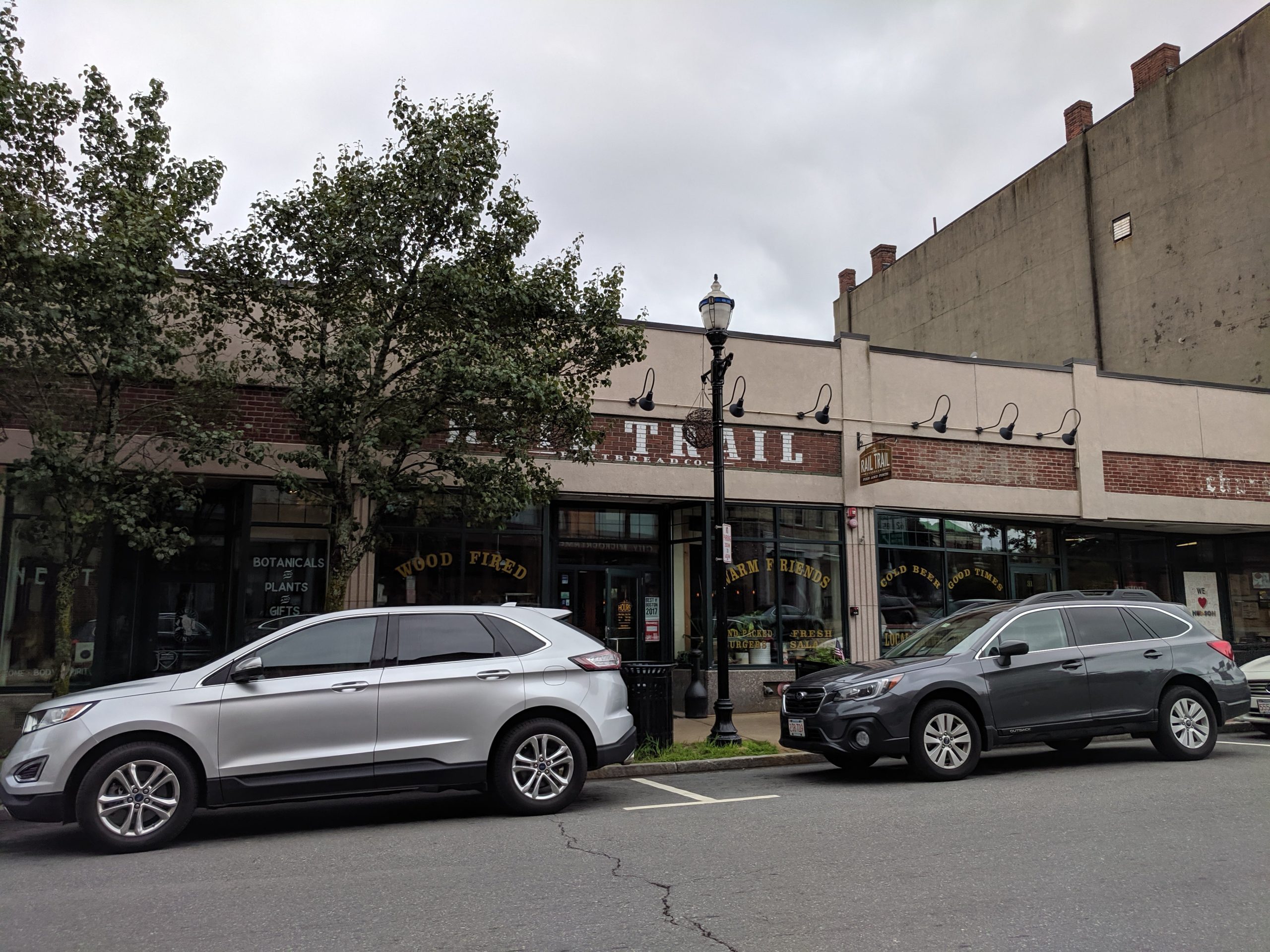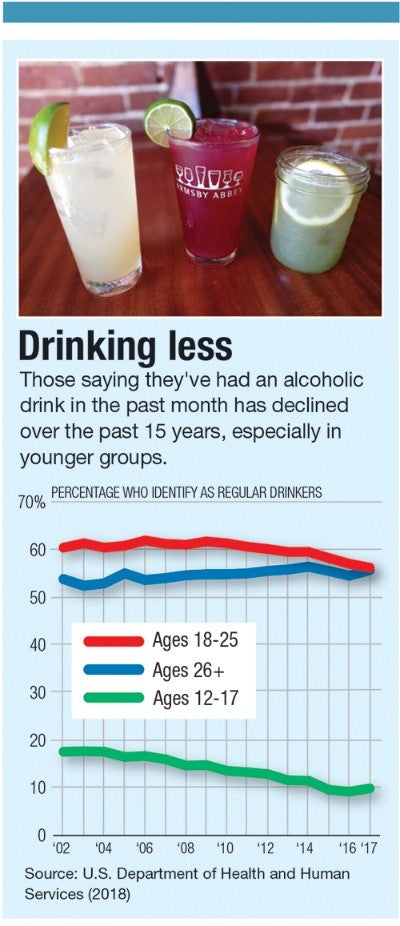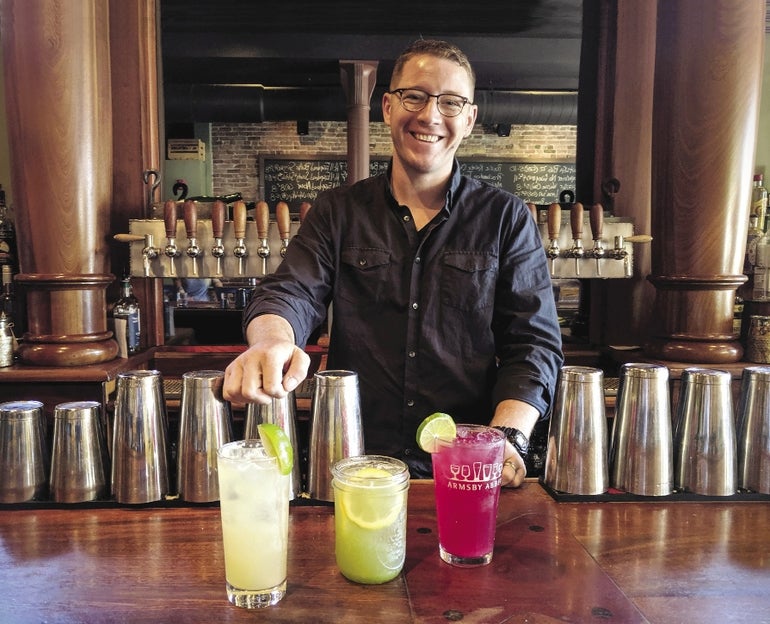When bartenders fix cocktails these days, they’re more often leaving out what used to be the most essential ingredient: the alcohol.
Get Instant Access to This Article
Subscribe to Worcester Business Journal and get immediate access to all of our subscriber-only content and much more.
- Critical Central Massachusetts business news updated daily.
- Immediate access to all subscriber-only content on our website.
- Bi-weekly print or digital editions of our award-winning publication.
- Special bonus issues like the WBJ Book of Lists.
- Exclusive ticket prize draws for our in-person events.
Click here to purchase a paywall bypass link for this article.
When bartenders fix cocktails these days, they’re more often leaving out what used to be the most essential ingredient: the alcohol.
In Central Massachusetts and nationally, bartenders say they’re being more creative at offering non-alcoholic drinks than in the past. Whether a patron is abstaining for health or religious reasons, or they’re pregnant or a designated driver, bartenders say they don’t judge.
The options that have always been there might still be possible, like a virgin daiquiri or pina colada; but bartenders – especially those who approach their job with enough of an artform they’re sometimes called mixologists – carefully consider how a good cocktail can be made by ways other than simply removing the alcohol.
“For me, this is here to be able to provide a great experience for someone for their visit,” said Silas Axtell, the bar manager at Worcester's Armsby Abbey.
Armsby’s non-alcoholic options include a virgin Moscow mule and other liquor-free variations of cocktails like an Irish whiskey and a cucumber-and-melon gin. The liquor itself doesn’t need to be so essential, he said.
“Bartending to me is providing a good experience to someone,” Axtell said.
Shifting tastes and more acceptance
That attitude is repeated beyond Armsby, a Worcester restaurant known for its exclusive beer selection but which added non-alcoholic cocktails to its drink menu in 2016.
Shayne Filo, the beverage director for Worcester’s Niche Hospitality Group, has found customers wanting non-alcoholic options other than sugary sodas. And lunch business is less likely to include the possibility of enjoying a few beers or glasses of wine.

Luke Doherty, the bar manager for sister Hudson establishments Rail Trail Flatbread Co. and Less Than Greater Than, sees the trend as the result of a craft cocktail movement, which offers more creative options than regular bar standbys. Rail Trail even sees kids ordering non-alcoholic cocktails to enjoy something unique.
“We’re not in the business of selling cocktails as much as we are a good experience,” Doherty said.
Bartenders say they work hard to ensure a cocktail still has the right taste and texture even without liquor. It’s not as simple as taking out the alcohol and mixing the rest. A Manhattan or a gin drink are some of the hardest to try making alcohol-free, while drinks with fruity or more complex ingredient lists leave some wiggle room.
“It does take some extra creativity sometimes to bring the flavors out,” Filo said.
If creating a new alcohol-free cocktail is a challenge for a bartender, it’s a part of a development of bartending into an artform, the way a chef can be with food, said Bob Luz, the president and CEO of the Massachusetts Restaurant Association.
“The mixologist development has really been extraordinary,” he said. “It’s really made a bartender like a chef behind the bar.
Restaurants have another incentive to prioritize non-alcoholic drinks: Even if they're usually less expensive than their adult counterparts, they still help drive more revenue than a soft drink.
New challenges, new focus
Prominent national names in bartending see making non-alcoholic drinks a sign of greater acceptance of not everyone at a bar necessarily wanting a drink. Even if that patron isn’t partaking in drinking in the same way, they may not want to settle for an iced tea or a seltzer.
“I definitely think that’s changed in recent years,” said Dave Arnold, a principal at Existing Conditions, a bar in New York’s Greenwich Village and the author of the cocktail book “Liquid Intelligence”.
“That’s really where we’re coming at it from,” Arnold said. “We want everyone to have the same level of experience, whether they’re drinking alcohol or not.”
Arnold is among those working to maintain what he said are the right balances of sweet or acidic flavors when alcohol is left out. He’ll substitute premium ingredients like honey made from a rare bee in Mexico, which is why alcohol-free drinks at Existing Conditions cost $16.
Customers have found more of a voice in wanting something more creative, said Clare Liardet, the author of the non-alcohol-bartending book “Dry: Delicious Handcrafted Cocktails and Other Clever Concoctions”.
“The rise in interest goes beyond that of simply taking out the bad, to actively seeking and exploring the healthy,” Liardet said. “So no more sweet pina colada, minus rum – but challenging fruits, vegetables, berries, and interesting bitter or herb drinks, perhaps using non-alcoholic distilled spirits to create that complex backbone a good cocktail needs.”

Arnold sees the trend continuing, considering bartending trade shows now including seminars on non-alcoholic drinks when they wouldn’t have five years ago. These days are something of a lag time between many patrons still not realizing how many quality non-alcoholic cocktails are available, he said.
Industry giants have noticed
No firm numbers exist on the rise of liquor-free cocktails, but the industry sees a growing market.
A longtime survey of young adults and youth from the U.S. Department of Health and Human Services has found declining alcohol use.
A 2018 World Health Organization report found 19% of Americans to be former drinkers. Roughly 28% of Americans said they abstained from alcohol within the last 12 months.
The non-alcoholic spirits industry remains very small, but grew by two-thirds between 2017 and 2018, according to IWSR Drinks Market Analysis. An IWSR survey in February found 52% of Americans are trying or have tried to reduce their alcohol intake.
In January, Coca-Cola launched sparkling non-alcoholic drinks inspired by their alcoholic cousins.
In August, Diageo – the British owner of Johnnie Walker, Captain Morgan and other major liquors – got into the game as well, buying a majority share of Seedlip, a company calling itself the world’s first distilled non-alcoholic spirit.
Brazilian-Belgian multinational drink manufacturer AB InBev, the maker of Anheuser-Busch and other international beers, counts alcohol-free drinks for just 10% of sales today, but projects those sales to reach 20% by 2025.

